[English] 日本語
 Yorodumi
Yorodumi- PDB-5jr4: Crystal structure of FimH A27V/V163A from E. coli UTI89 bound to ... -
+ Open data
Open data
- Basic information
Basic information
| Entry | Database: PDB / ID: 5jr4 | ||||||
|---|---|---|---|---|---|---|---|
| Title | Crystal structure of FimH A27V/V163A from E. coli UTI89 bound to FimG N-terminal extension | ||||||
 Components Components |
| ||||||
 Keywords Keywords | SUGAR BINDING PROTEIN / lectin / immunoglobulin fold / carbohydrate binding protein / donor strand exchange | ||||||
| Function / homology |  Function and homology information Function and homology informationcell adhesion involved in single-species biofilm formation / pilus / metal ion binding Similarity search - Function | ||||||
| Biological species |  | ||||||
| Method |  X-RAY DIFFRACTION / X-RAY DIFFRACTION /  MOLECULAR REPLACEMENT / Resolution: 2.596 Å MOLECULAR REPLACEMENT / Resolution: 2.596 Å | ||||||
 Authors Authors | Kalas, V. / Hultgren, S.J. | ||||||
 Citation Citation |  Journal: Sci Adv / Year: 2017 Journal: Sci Adv / Year: 2017Title: Evolutionary fine-tuning of conformational ensembles in FimH during host-pathogen interactions. Authors: Vasilios Kalas / Jerome S Pinkner / Thomas J Hannan / Michael E Hibbing / Karen W Dodson / Alex S Holehouse / Hao Zhang / Niraj H Tolia / Michael L Gross / Rohit V Pappu / James Janetka / Scott J Hultgren /  Abstract: Positive selection in the two-domain type 1 pilus adhesin FimH enhances fitness in urinary tract infection (UTI). We report a comprehensive atomic-level view of FimH in two-state conformational ...Positive selection in the two-domain type 1 pilus adhesin FimH enhances fitness in urinary tract infection (UTI). We report a comprehensive atomic-level view of FimH in two-state conformational ensembles in solution, composed of one low-affinity tense (T) and multiple high-affinity relaxed (R) conformations. Positively selected residues allosterically modulate the equilibrium between these two conformational states, each of which engages mannose through distinct binding orientations. A FimH variant that only adopts the R state is severely attenuated early in a mouse model of uncomplicated UTI but is proficient at colonizing catheterized bladders in vivo or bladder transitional-like epithelial cells in vitro. Thus, the bladder habitat has barrier(s) to R state-mediated colonization possibly conferred by the terminally differentiated bladder epithelium and/or decoy receptors in urine. Together, our studies reveal the conformational landscape in solution, binding mechanisms, and adhesive strength of an allosteric two-domain adhesin that evolved "moderate" affinity to optimize persistence in the bladder during UTI. | ||||||
| History |
|
- Structure visualization
Structure visualization
| Structure viewer | Molecule:  Molmil Molmil Jmol/JSmol Jmol/JSmol |
|---|
- Downloads & links
Downloads & links
- Download
Download
| PDBx/mmCIF format |  5jr4.cif.gz 5jr4.cif.gz | 68.7 KB | Display |  PDBx/mmCIF format PDBx/mmCIF format |
|---|---|---|---|---|
| PDB format |  pdb5jr4.ent.gz pdb5jr4.ent.gz | 49.2 KB | Display |  PDB format PDB format |
| PDBx/mmJSON format |  5jr4.json.gz 5jr4.json.gz | Tree view |  PDBx/mmJSON format PDBx/mmJSON format | |
| Others |  Other downloads Other downloads |
-Validation report
| Summary document |  5jr4_validation.pdf.gz 5jr4_validation.pdf.gz | 440.7 KB | Display |  wwPDB validaton report wwPDB validaton report |
|---|---|---|---|---|
| Full document |  5jr4_full_validation.pdf.gz 5jr4_full_validation.pdf.gz | 443.6 KB | Display | |
| Data in XML |  5jr4_validation.xml.gz 5jr4_validation.xml.gz | 12.9 KB | Display | |
| Data in CIF |  5jr4_validation.cif.gz 5jr4_validation.cif.gz | 16.6 KB | Display | |
| Arichive directory |  https://data.pdbj.org/pub/pdb/validation_reports/jr/5jr4 https://data.pdbj.org/pub/pdb/validation_reports/jr/5jr4 ftp://data.pdbj.org/pub/pdb/validation_reports/jr/5jr4 ftp://data.pdbj.org/pub/pdb/validation_reports/jr/5jr4 | HTTPS FTP |
-Related structure data
| Related structure data |  5jqiC  1klfS C: citing same article ( S: Starting model for refinement |
|---|---|
| Similar structure data |
- Links
Links
- Assembly
Assembly
| Deposited unit | 
| ||||||||
|---|---|---|---|---|---|---|---|---|---|
| 1 |
| ||||||||
| Unit cell |
|
- Components
Components
| #1: Protein | Mass: 29037.260 Da / Num. of mol.: 1 / Fragment: UNP residues 22-300 / Mutation: A27V, V163A Source method: isolated from a genetically manipulated source Source: (gene. exp.)  Strain: UTI89 / UPEC / Gene: fimH, UTI89_C5017 / Production host:  |
|---|---|
| #2: Protein/peptide | Mass: 1513.776 Da / Num. of mol.: 1 / Source method: obtained synthetically Source: (synth.)  References: UniProt: Q1R2J5*PLUS |
| #3: Chemical | ChemComp-GOL / |
| #4: Chemical | ChemComp-CA / |
| #5: Water | ChemComp-HOH / |
| Has protein modification | Y |
-Experimental details
-Experiment
| Experiment | Method:  X-RAY DIFFRACTION / Number of used crystals: 1 X-RAY DIFFRACTION / Number of used crystals: 1 |
|---|
- Sample preparation
Sample preparation
| Crystal | Density Matthews: 2.06 Å3/Da / Density % sol: 40.33 % |
|---|---|
| Crystal grow | Temperature: 293 K / Method: vapor diffusion, hanging drop / pH: 5.6 Details: 0.1 M MES pH 5.6, 0.2 M Calcium Acetate, 5% PEG 8000 |
-Data collection
| Diffraction | Mean temperature: 100 K |
|---|---|
| Diffraction source | Source:  ROTATING ANODE / Type: RIGAKU MICROMAX-007 / Wavelength: 1.54179 Å ROTATING ANODE / Type: RIGAKU MICROMAX-007 / Wavelength: 1.54179 Å |
| Detector | Type: MAR scanner 345 mm plate / Detector: IMAGE PLATE / Date: Mar 18, 2016 |
| Radiation | Protocol: SINGLE WAVELENGTH / Monochromatic (M) / Laue (L): M / Scattering type: x-ray |
| Radiation wavelength | Wavelength: 1.54179 Å / Relative weight: 1 |
| Reflection | Resolution: 2.59→62.35 Å / Num. obs: 7964 / % possible obs: 99.3 % / Redundancy: 6.4 % / Rmerge(I) obs: 0.164 / Net I/σ(I): 8.1 |
| Reflection shell | Resolution: 2.59→2.73 Å / Redundancy: 6 % / Rmerge(I) obs: 0.482 / Mean I/σ(I) obs: 3.3 / % possible all: 95.1 |
- Processing
Processing
| Software |
| ||||||||||||||||||||||||||||
|---|---|---|---|---|---|---|---|---|---|---|---|---|---|---|---|---|---|---|---|---|---|---|---|---|---|---|---|---|---|
| Refinement | Method to determine structure:  MOLECULAR REPLACEMENT MOLECULAR REPLACEMENTStarting model: 1KLF Resolution: 2.596→62.348 Å / SU ML: 0.34 / Cross valid method: FREE R-VALUE / σ(F): 1.34 / Phase error: 28.58 / Stereochemistry target values: ML
| ||||||||||||||||||||||||||||
| Solvent computation | Shrinkage radii: 0.9 Å / VDW probe radii: 1.11 Å / Solvent model: FLAT BULK SOLVENT MODEL | ||||||||||||||||||||||||||||
| Refinement step | Cycle: LAST / Resolution: 2.596→62.348 Å
| ||||||||||||||||||||||||||||
| Refine LS restraints |
| ||||||||||||||||||||||||||||
| LS refinement shell |
|
 Movie
Movie Controller
Controller


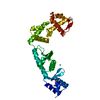
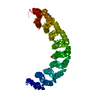
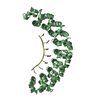

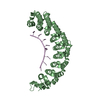
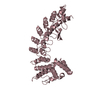
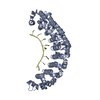

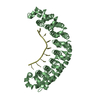
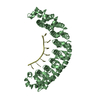
 PDBj
PDBj









